การเสริมโปรตีนไฮโดรไลเซทจากการย่อยเปลือกกุ้งป่นและกระดูกปลาป่นด้วยเอนไซม์บรอมีเลนและเอนไซม์ปาเปนในอาหารต่อการเติบโตของปลาดุกลูกผสม (Clarias macrocephalus × Clarias garepinus)
Main Article Content
บทคัดย่อ
ความเป็นมาและวัตถุประสงค์: เศษเหลือทิ้งจากครัวเรือนและร้านอาหารจำพวกเปลือกกุ้งและกระดูกปลามีจำนวนมาก จึงสนใจนำมาใช้เป็นวัตถุดิบอาหารสัตว์น้ำ เพื่อศึกษาการเสริมโปรตีนไฮโดรไลเซทจากเปลือกกุ้งและกระดูกปลาย่อยด้วยเอนไซม์บรอมีเลนและปาเปนในอาหารปลาดุกลูกผสม
วิธีดำเนินการวิจัย: วางแผนการทดลองแบบ 2 × 2 แฟกทอเรียลในแผนแบบการทดลองสุ่มสมบูรณ์ จำนวน 3 ซ้ำ ประกอบด้วย ปัจจัย A คือ วัตถุดิบอาหารสัตว์ (เปลือกกุ้งป่น และกระดูกปลาป่น) และปัจจัย B คือ เอนไซม์สกัด (เอนไซม์บรอมีเลน และเอนไซม์ปาเปน) เลี้ยงปลาดุกลูกผสมด้วยการให้อาหารทดลองในปริมาณร้อยละ 5 ของน้ำหนักตัวต่อวัน วันละ 2 มื้อ ชั่งน้ำหนักปลาและเก็บข้อมูลการเจริญเติบโตทุก 2 สัปดาห์ เป็นเวลา 2 เดือน
ผลการวิจัย: วัตถุดิบอาหารกับเอนไซม์มีอิทธิพลร่วมกันต่อคุณภาพโปรตีนไฮโดรไลเซทที่ได้ โดยเอนไซม์บรอมีเลนสามารถย่อยกระดูกปลาป่นทำให้โปรตีนไฮโดรไลเซทที่ได้มีคุณภาพ เมื่อนำไปเสริมในอาหารทำให้การเจริญเติบโตดีกว่าปลาดุกลูกผสมทุกกลุ่มและดีกว่าอย่างมีนัยสำคัญ เมื่อเทียบกับกลุ่มที่ได้รับอาหารเสริมโปรตีนไฮโดรไลเซทที่ได้จากเอนไซม์บรอมีเลนย่อยเปลือกกุ้งป่น โดยมีน้ำหนักสุดท้ายเท่ากับ 16.50 ± 1.41 กรัมต่อตัว น้ำหนักที่เพิ่มขึ้นเท่ากับ 9.31 ± 1.47 กรัมต่อตัว และน้ำหนักที่เพิ่มขึ้นต่อวันเท่ากับ 0.17 ± 0.03 กรัมต่อตัวต่อวัน (P < 0.05) ส่วนต้นทุนค่าอาหาร พบว่า อาหารเสริมโปรตีนไฮโดรไลเซทจากกระดูกปลาป่นย่อยด้วยเอนไซม์บรอมีเลนมีต้นทุนต่ำกว่าราคาจำหน่ายอาหารเม็ดสำเร็จรูปทางการค้า
สรุป: การใช้โปรตีนไฮโดรไลเซทที่ได้จากการย่อยกระดูกปลาป่นด้วยเอนไซม์บรอมีเลนเสริมในอาหารปลาดุกสามารถส่งเสริมการเจริญเติบโตของปลาและเป็นแนวทางการใช้ประโยชน์จากเศษเหลือทิ้งให้เป็นวัตถุดิบทางเลือกในการลดต้นทุนค่าอาหารสัตว์น้ำได้
Article Details

อนุญาตภายใต้เงื่อนไข Creative Commons Attribution-NonCommercial-NoDerivatives 4.0 International License.
เอกสารอ้างอิง
AOAC. 2012. Official Method of Analysis of AOAC International. 19th edition. Association of Official Agricultural Chemists, Washington, D.C., USA.
Clemente, A. 2000. Enzymatic protein hydrolysates in human nutrition. Trends Food Sci. Technol. 11(7): 254–262. https://doi.org/10.1016/S0924-2244(01)00007-3.
Didgrew, A., P. Siriwan, N. Thongwittaya and W. Prokati. 2008. Effect of papain supplementation on productive performance in broilers. Journal of Agricultural Research and Extension 25(2): 17–23. (in Thai)
Faivishevskii, M.L., T.N. Lisina, S.I. Khvyiya and T.G. Kuznctsova. 1992. Utilization of bone protein fractions. Myasnaya Promyshlennost. 2: 14–15.
Garnjanagoonchorn, W. and S. Trevanich. 2015. Development of shrimp flavor seasoning from head scraps and shrimp shells. Available Source: https://www3.rdi.ku.ac.th/?p=19331, August 22, 2022. (in Thai)
Ingweye, J.N., B.I. Okon, J.A. Ubua and A.I. Essien. 2008. Performance of broiler chickens fed fish and shrimp wastes. Asian J. Anim. Sci. 2(2): 58–63. https://doi.org/10.3923/ajas.2008.58.63.
Jintasataporn, O. 2010. Aquatic animal feed (251371). Teaching Publications. Department of Aquaculture, Faculty of Fisheries, Kasetsart University, Bangkok, Thailand. (in Thai)
Jodnak, S. 2012. Biological Activity of Tilapia Bone Protein Hydrolysate and Its Effects on Osteoblasts. MS Thesis, Prince of Songkla University, Songkla. (in Thai)
Karaket, T., M. Seel-audom and B. Yuangsoi. 2022. Partial replacement of fish meal with blood meal in diet on growth performance for nursing red tilapia (Oreochromis spp.). BUSCIJ. 27(2): 801–814. (in Thai)
Kim, S.W. and N. Rajapakse. 2005. Enzymatic production and biological activities of chitosan oligosaccharides (COS): a review. Carbohydr. Polym. 62(4): 357–368. https://doi.org/10.1016/j.carbpol.2005.08.012.
Kingkaew, K. 2020. Bromelain: protein digestion enzymes from pineapple. TISTR. 35(2): 28–31. (in Thai)
Kuakaew, J., P. Muangyao, P. Plaipetch, M. Prayunpun and S. Thongrod. 2012. Protein hydrolysate from shrimp waste as protein sources for fishmeal replacement in formulated feed for Asian seabass (Lates calcarifer Bloch, 1790). Technical Paper No. 15/2012. Department of Fisheries, Bangkok, Thailand. (in Thai).
Mahata, M.E., A. Dharma, H.I. Ryanto and Y. Rizal. 2008. Effect of substituting shrimp waste hydrolysate of Penaeus merguensis for fish meal in broiler performance. Pak. J. Nutr. 7(6): 806–810. https://doi.org/10.3923/pjn.2008.806.810.
Meyers, S.P., J.M. Rutledge and S.C. Sonu. 1973. Variability in proximate analysis of different processed shrimp meals. Feedstuffs. 45: 34–35.
Ngoan, L.D., J.E. Lindberg, B. Ogle and S. Thomke. 2000. Anatomical proportions and chemical and amino acid composition of common shrimp species in central Vietnam. Asian-Australas. J. Anim. Sci. 13(10): 1422–1428. https://doi.org/10.5713/ajas.2000.1422.
Rao, M.B., A.M. Tanksale, M.S. Ghatge and W. Deshpande. 1998. Molecular and biotechnological aspects of microbial proteases. Microbiol. Mol. Biol. Rev. 62(3): 597–635. https://doi.org/10.1128/mmbr.62.3.597-635.1998.
Suwan, W. 2002. Production of Gelatin from Red Snapper Bones. MS Thesis, Kasetsart University, Bangkok. (in Thai)
Suwannaphan, S., S. Pacharean and P. Thongrak. 2018. Production of Protein Hydrolysates from Catfish Waste using Plant Enzymes. Research Report. Faculty of Agricultural Technology and Agro-Industry, Rajamangala University of Technology Suvarnabhumi, Phra Nakhon Si Ayutthaya, Thailand. (in Thai)
Toppe, J., S. Albrektsen, B. Hope and A. Aksnes. 2007. Chemical composition, mineral content and amino acid and lipid profiles in bones from various fish species. Comp. Biochem. Physiol. B Biochem. Mol. Biol. 146(3): 395–401. https://doi.org/10.1016/j.cbpb.2006.11.020.
Vignesh, R. and M. Srinivasan. 2012. Nutritional quality of processed head and bone flours of Tilapia (Oreochromis mossambicus, Peters 1852) from Parangipettai estuary, South East Coast of India. Asian Pac. J. Trop. Biomed. 2(1): S368–S372. https://doi.org/10.1016/S2221-1691(12)60189-0.
Vorachantra, S. and R. Sitthigripong. 1996. Animal Nutrition. Odeon Store Press, Bangkok, Thailand. (in Thai)
Younes, I., O. Ghorbel-Bellaaj, R. Nasri, M. Chaabouni, M. Rinaudo and M. Nasri. 2012. Chitin and chitosan preparation from shrimp shells using optimized enzymatic deproteinization. Process Biochem. 47(12): 2032–2039. https://doi.org/10.1016/j.procbio.2012.07.017.
Younes, I., S. Hajji, V. Frachet, M. Rinaudo, K. Jellouli and M. Nasri. 2014. Chitin extraction from shrimp shell using enzymatic treatment. Antitumor, antioxidant and antimicrobial activities of chitosan. Int. J. Biol. Macromol. 69: 489–498. https://doi.org/10.1016/j.ijbiomac.2014.06.013.


